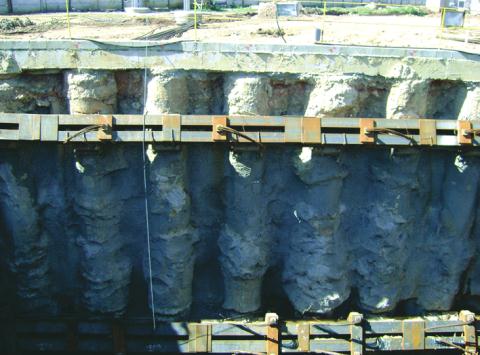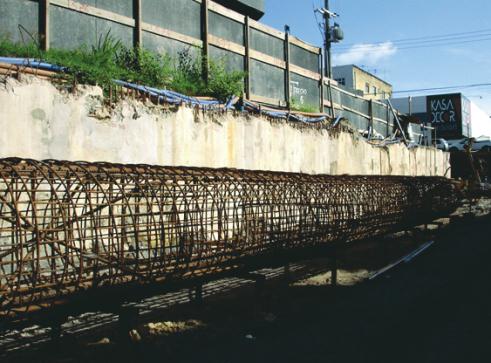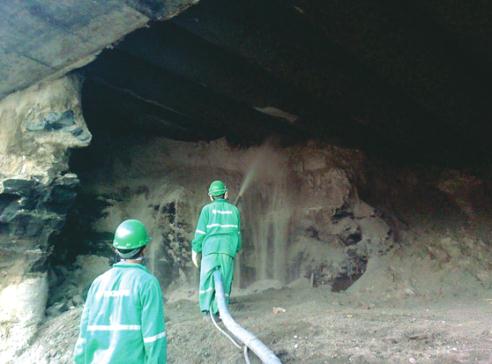Basic HTML Version



782
IBRACON Structures and Materials Journal • 2012 • vol. 5 • nº 6
Shear strength of reinforced concrete circular cross-section beams
1. Introduction
Reinforced concrete circular cross-section beams are often used
in infrastructure works, such as retaining structures for excavations
(Figure 1). Utilization of circular cross-section beams for shallow
tunnels has also been verified in recent projects.(Maffei [8], [9])
(Figure 2).
The determination of shear strength of these elements on Ultimate
Limit States must be made by the expression given on item 17.4
of NBR 6118 [1]. However, the application of the Brazilian Stan-
dard expression for circular cross-section beams presents some
problems, such as: (a) the applicability of the expression used for
the determination of V
Rd2
, the shear strength design related to the
concrete failure by diagonal compression; (b) the definition of the
value of b
w
for the calculation of V
c
, the parcel of shear force resisted
for complementary mechanisms to truss; (c) doubts related to the
efficiency of circular stirrups in shear strength when determining V
sw
,
the portion of the shear force resisted by shear reinforcement.
Attempts to cover this subject are found in literature [2], [3], [4],
[5], [6]. Jensen et al. [2], present the test results of sixteen circu-
lar beams. The tested beams had a diameter of 25cm and were
reinforced with different longitudinal and transverse arrange-
ments (Figure 3). The cited authors used the American Standard
AASHTO LFRD Bridge Design Specifications, 2007 [11],to esti-
mate the resistance of the tested beams. The presented results
suggests that the application of the expressions of AASHTO (2007)
may lead to safe values of shear strength of reinforced concrete
circular cross-section beams as shown in the item 4 of this study.
Merta [4], presents analytical model for determining the shear
strength of reinforced concrete beams of circular section. For de-
termining the value of V
c
, the above author presents expressions
in which the influence of the main variables were empirically deter-
mined based on the results of 44 testing circular beams reinforced
only with longitudinal rebars , ie, without the use of stirrups. For
the calculation of V
sw
, Merta [4] proposes model that takes into
account the curved stirrup sand divides the contribution of the
reinforcement into two parts: the vertical component of force in the
stirrup crossing this hear crack and over an additional portion due
to radial forces that a rise due to the adhesion between the steel
and concrete.
A useful concept introduced by Merta & Kolbitsch [5] and Li [3] is
the effective area (A
ef
) for shear force, also called “shear area” in
one of the works.
A similar concept is used by the Brazilian code of steel structures,
NBR8800 (2010). According to this standard, the effective area
in this context would be that obtained by the ratio V/ζ
máx
, where
Vis the shear force in the section and ζ
máx
is the maximum shear
stress in the section obtained with Jourávski expression[7]. The
Figure 1– Example of application
of circular cross section elements of
reinforced concrete working as beams
in a retaining structure (Maffei, [8])
A
B
Figure 2 – Example of application of reinforced concrete circular cross section elements working
as beams in a shallow tunnel (Maffei, [9]): (a) details of the reinforcement; (b) concluded beams

